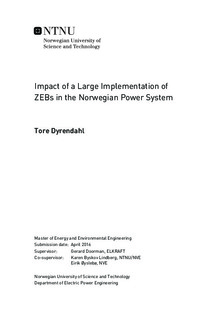| dc.description.abstract | In the Energy Performance of Buildings Directive (EPBD), all new buildings are said to be nearly Zero Energy Buildings (ZEBs) from 2018/2020. A Zero Energy Building is a building that has a lower demand for energy, and is able to produce the same amount of energy which it uses during the year.
This thesis analyzes the impact of a large implementation of ZEBs in the Norwegian power system. With an expected increasing share of ZEB due to the EPBD, it is important to analyze the impact on the power system, in order to prepare the power system for the consequences of such large changes. The analysis is performed by running simulations in the EMPS model. Several cases has been analyzed, and they differ from each other by the share of ZEBs, choice of heating technology, demand and PV-production.
The model setup contains projections of demand and installed capacity of different production technologies, as well as expected interconnections to surrounding countries in 2030.
A large implementation of ZEBs gives reduced demand during winter and increased PV-production during summer. This results in an increased surplus in the power balance in Norway of 23.8-37.4 TWh, depending on choice of heating technology, compared with the reference case BAU (''Business as usual''). The surplus of power decreases some in the other Nordic countries.
The total CO2 emissions from power production within the Nordic countries is reduced, due to lower production from thermal power plants, mostly coal-fired plants. The reduction of CO2 emissions is between 3.53 and 5.68 mill. tons for the ZEB-cases. The CO2 emissions per kWh produced in the Nordic power system reduces from 97.8 gCO2/kWh in the reference case to 87.3-83.2 gCO2/kWh in the ZEB-cases.
The cases with increased PV-production has a significantly different reservoir handling than the cases without PV-production. The average reservoir level is lower due to the predictable PV-production in the summer. The reduction in reservoir level is between 6-11 percentage points throughout the year. The difference is highest in the spring and summer.
The average prices is reduced, especially in the summer. Also the classic price reduction during the spring inflow is amplified. In a chosen summer week the classic daily price profile is turned up side down in the cases with PV-production, giving the highest price during late evening and night. In a wet year the system experiences a price collapse, while in a dry year there is slightly an increase in price compared to a normal year. In the ZEB-cases the price collapse is present in several years.
Due to higher production and lower prices, the export increases. The share of maximum export is 6 % for the reference case, while it increases to 25-37 % for the ZEB-cases. Compared with the reference case BAU, where it is import during winter and export during summer, two out of three ZEB-cases will on a weekly, average level, only export power, during the year. | |

